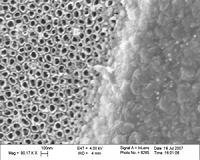 |
Raleigh NC (SPX) Mar 28, 2011 Carbon nanofibers hold promise for technologies ranging from medical imaging devices to precise scientific measurement tools, but the time and expense associated with uniformly creating nanofibers of the correct size has been an obstacle - until now. A new study from North Carolina State University demonstrates an improved method for creating carbon nanofibers of specific sizes, as well as explaining the science behind the method. "Carbon nanofibers have a host of potential applications, but their utility is affected by their diameter - and controlling the diameter of nanofibers has historically been costly and time-consuming," says Dr. Anatoli Melechko, an associate professor of materials science and engineering at NC State and co-author of a paper describing the study. Specifically, the researchers have shown that nickel nanoparticles coated with a ligand shell can be used to grow carbon nanofibers that are uniform in diameter. Ligands are small organic molecules that have functional groups (parts of the molecule) that bond directly to metals. Nickel nanoparticles are of particular interest because - at high temperatures - they can serve as catalysts for growing carbon nanofibers. "What we learned is that the ligand shell, which is composed of trioctylphosphine, undergoes chemical changes at high temperatures - gradually transforming into a graphite-like shell," says Dr. Joe Tracy, a co-author of the paper and assistant professor of materials science and engineering at NC State. "These 'graphitic' shells prevent the nickel nanoparticles from lumping together at elevated temperatures, which is a problem for high-temperature applications involving nanoparticles." Using nanoparticles to grow nanofibers is useful, because the fibers tend to have the same diameter as the nanoparticles they are growing from. If you need nanofibers that are 20 nanometers (nm) in diameter, you would simply use nanoparticles that are 20 nm in diameter as your catalyst. "This is why controlling the diameter of the nanoparticles is important. If they begin to lump together at high temperatures, you end up growing nanofibers of many different, larger sizes," Melechko says. "This research gives us a better fundamental understanding of the relationship between nickel nanoparticles, ligands and carbon nanofiber synthesis." Using nanoparticles to grow nanofibers has another benefit - it allows you to define where the nanofibers grow and how they are arranged. If you need the nanofibers to grow in a specific pattern, you would arrange the nanoparticles in that pattern before growing the fibers. The paper, "Effects of Ligand Monolayers on Catalytic Nickel Nanoparticles for Synthesizing Vertically Aligned Carbon Nanofibers," was published online March 17 in ACS Applied Materials and Interfaces. The paper was co-authored by Melechko, Tracy; NC State Ph.D. students Mehmet Sarac, Aaron Johnston-Peck and Ryan Pearce; NC State undergraduate Robert Wilson; former NC State post-doctoral research associate Dr. Junwei Wang; and Dr. Kate Klein of the National Institute of Standards and Technology. The research was funded by the National Science Foundation, U.S. Department of Energy, U.S. Department of Education, the Republic of Turkey and Protochips, Inc. NC State's Department of Materials Science and Engineering is part of the university's College of Engineering.
Share This Article With Planet Earth
Related Links North Carolina State University Nano Technology News From SpaceMart.com Computer Chip Architecture, Technology and Manufacture
 Nanomodified Surfaces Seal Leg Implants Against Infection
Nanomodified Surfaces Seal Leg Implants Against InfectionProvidence RI (SPX) Mar 25, 2011 In recent years, researchers have worked to develop more flexible, functional prosthetics for soldiers returning home from battlefields in Afghanistan or Iraq with missing arms or legs. But even new prosthetics have trouble keeping bacteria from entering the body through the space where the device has been implanted. "You need to close (the area) where the bacteria would enter the body, an ... read more |
|
| The content herein, unless otherwise known to be public domain, are Copyright 1995-2010 - SpaceDaily. AFP and UPI Wire Stories are copyright Agence France-Presse and United Press International. ESA Portal Reports are copyright European Space Agency. All NASA sourced material is public domain. Additional copyrights may apply in whole or part to other bona fide parties. Advertising does not imply endorsement,agreement or approval of any opinions, statements or information provided by SpaceDaily on any Web page published or hosted by SpaceDaily. Privacy Statement |